Elevate your dinner with this delectable Steak and Shrimp Surf and Turf one-pan recipe! It’s the perfect combination of juicy steaks, seared to perfection in a sizzling skillet, and succulent jumbo shrimp, seasoned with the best spices. This restaurant-quality dish is surprisingly easy to make at home, and the flavors are simply unforgettable!
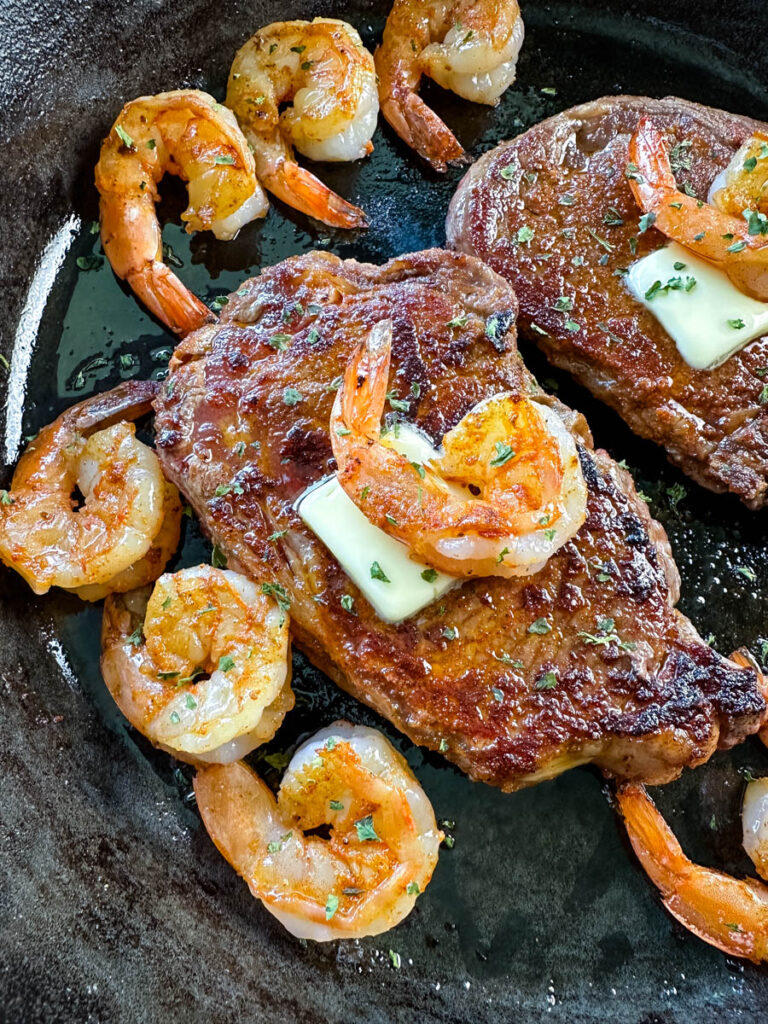
This post contains affiliate links. Please read my full disclosure here.
Why You Will Love This Recipe
- Flavor Contrasts: Surf and turf dishes provide a delightful contrast in flavors and textures. The richness and tenderness of the meat complement the delicacy and freshness of the seafood, creating a harmonious balance on the plate.
- Variety: Combining two distinct types of proteins on one plate allows diners to enjoy a diverse range of flavors and culinary experiences in a single meal, catering to a variety of tastes.
- Special Occasions: This dish is often associated with special occasions or celebratory meals due to its indulgent nature, making it a popular choice for romantic dinners or festive gatherings.
- Luxuriousness: The combination of premium ingredients, such as a succulent steak or lobster tail, contributes to the perception of luxury and sophistication associated with surf and turf dishes.
What is Surf and Turf
It’s a popular dish that typically combines seafood, usually lobster or shrimp, with a cut of red meat, commonly steak. The name “surf and turf” comes from the fact that it combines ingredients from both land (steak) and sea (seafood).
The dish is often served in high-end restaurants or as a special treat during special occasions. The combination of tender and juicy steak with succulent and flavorful seafood creates an amazing contrast of flavors and textures on the plate.
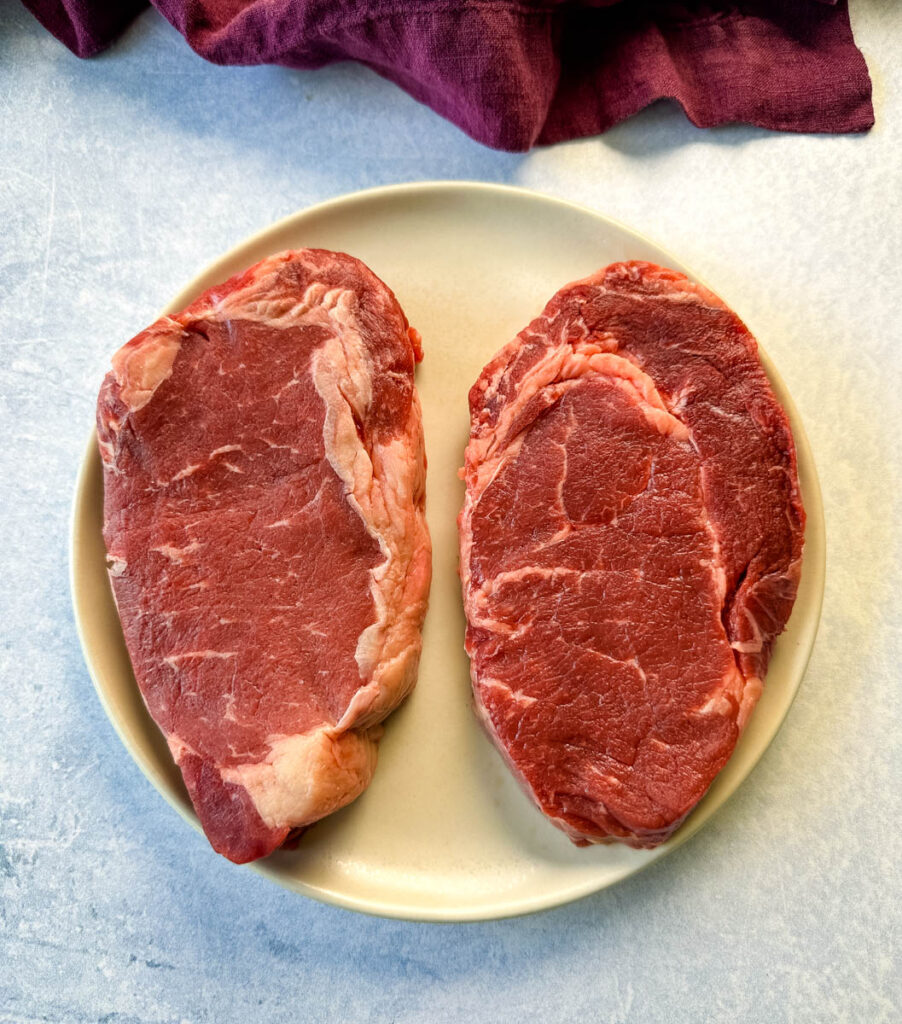
What Type of Steak to Use
The best type to use will depend on your personal preference. I use ribeyes. Here are some popular options:
- Ribeye: A juicy and well-marbled cut known for its intense beefy flavor. The richness of ribeye can balance the lightness of the seafood and add depth.
- Filet Mignon: A tender and lean cut of beef that is highly prized for its tenderness and mild flavor. Its buttery texture complements the delicate taste of seafood.
- New York Strip: Also known as strip loin or top loin, is a well-marbled and flavorful cut of steak. Its rich taste pairs nicely with the sweetness of seafood.
- Tenderloin: Similar to filet mignon, tenderloin is a tender and lean cut that works well with seafood due to its mild taste.
Each of these cuts offers a unique flavor and texture profile, so you can choose the one that best suits your taste preferences and budget.
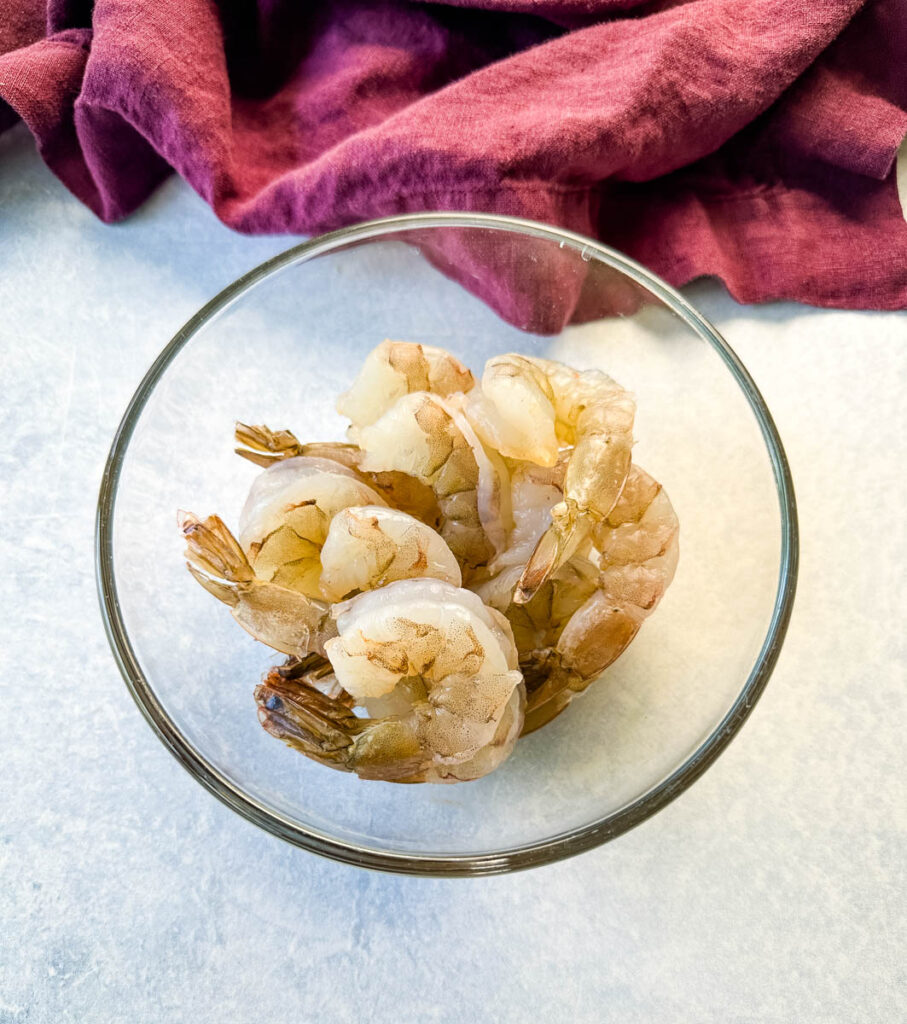
What Type of Shrimp to Use
Large or jumbo shrimp are a great choice for surf and turf because they have a substantial size and meaty texture. They can stand up well to the heartiness of the steak and offer a satisfying bite.
When shopping for shrimp refer to our Shrimp Size Guide and Counts Per Pound, 21-30 count will work well.
I recommend grabbing shrimp that has already been deveined so that you can save time skipping this step. Deveining in the process to remove the digestive tract or “vein” that runs along the back of the shrimp.
I prefer wild-caught shrimp. Farm-raised shrimp are raised in captivity on a shrimp farm. These farms can be located in ponds or in tanks on land. The shrimp are typically fed a diet of fishmeal, soy, and other ingredients, and are sometimes given antibiotics or other chemicals to prevent disease. Those chemicals are then passed into the food you eat.
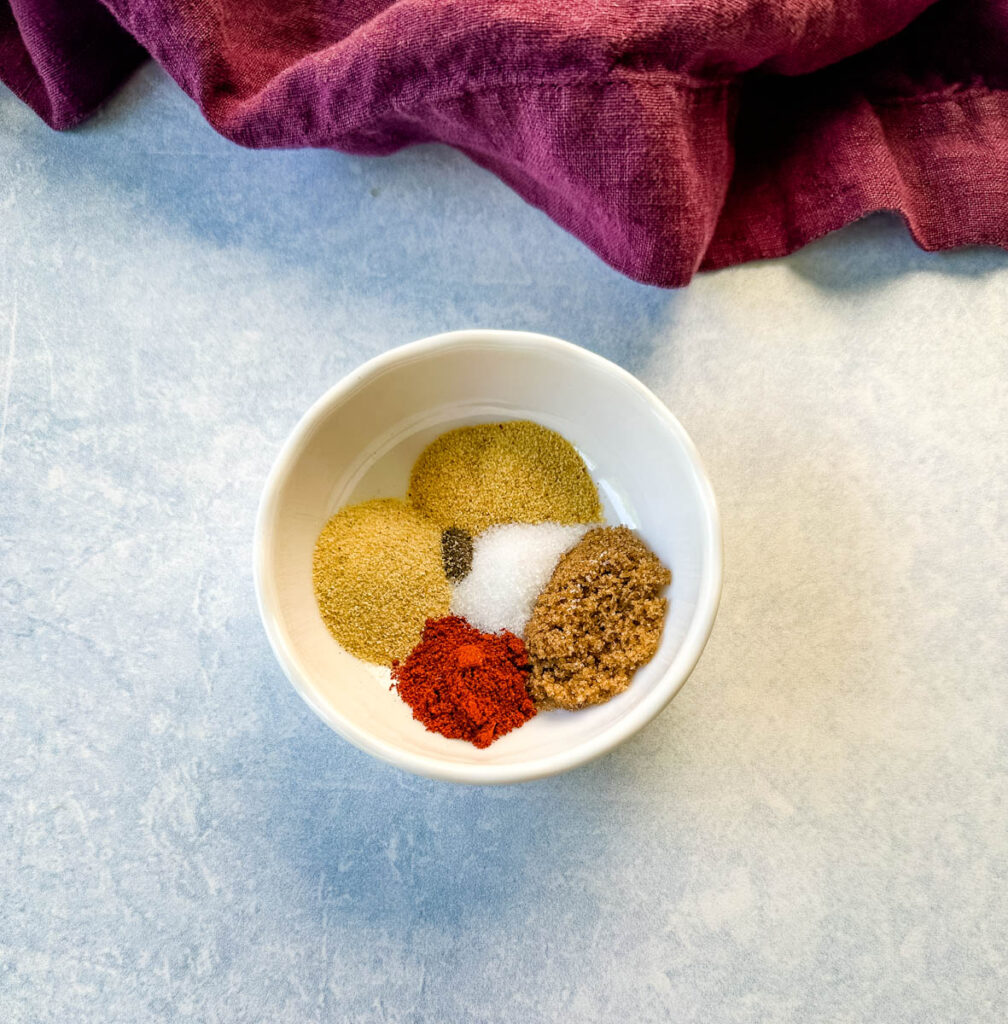
How to Season and Add Flavor
For the steak I like to use a blend of brown sugar or sweetener, smoked paprika, garlic powder, onion powder, salt, and pepper. You can also use your favorite steak rub.
For the shrimp, I combine smoked paprika, garlic powder, onion powder, salt, and pepper. You can also use store bought seafood seasoning. Here are more options:
- Lemon Pepper: A classic combination of lemon zest and black pepper for a bright and zesty flavor.
- Old Bay Seasoning: A versatile seafood seasoning with paprika, mustard, celery salt, and other spices.
- Garlic Butter: Toss the shrimp in melted butter infused with minced garlic for a rich and buttery taste.
- Blackened Seasoning: A spicy mix of paprika, cayenne pepper, thyme, and other herbs, perfect for blackened shrimp.
- Honey Lime: Marinate the shrimp in a mixture of honey, lime juice, and a pinch of chili flakes for a sweet and tangy glaze.
- Chimichurri Sauce: Drizzle a traditional Argentinian sauce made with parsley, garlic, vinegar, and olive oil over the cooked steak for a fresh and tangy taste.
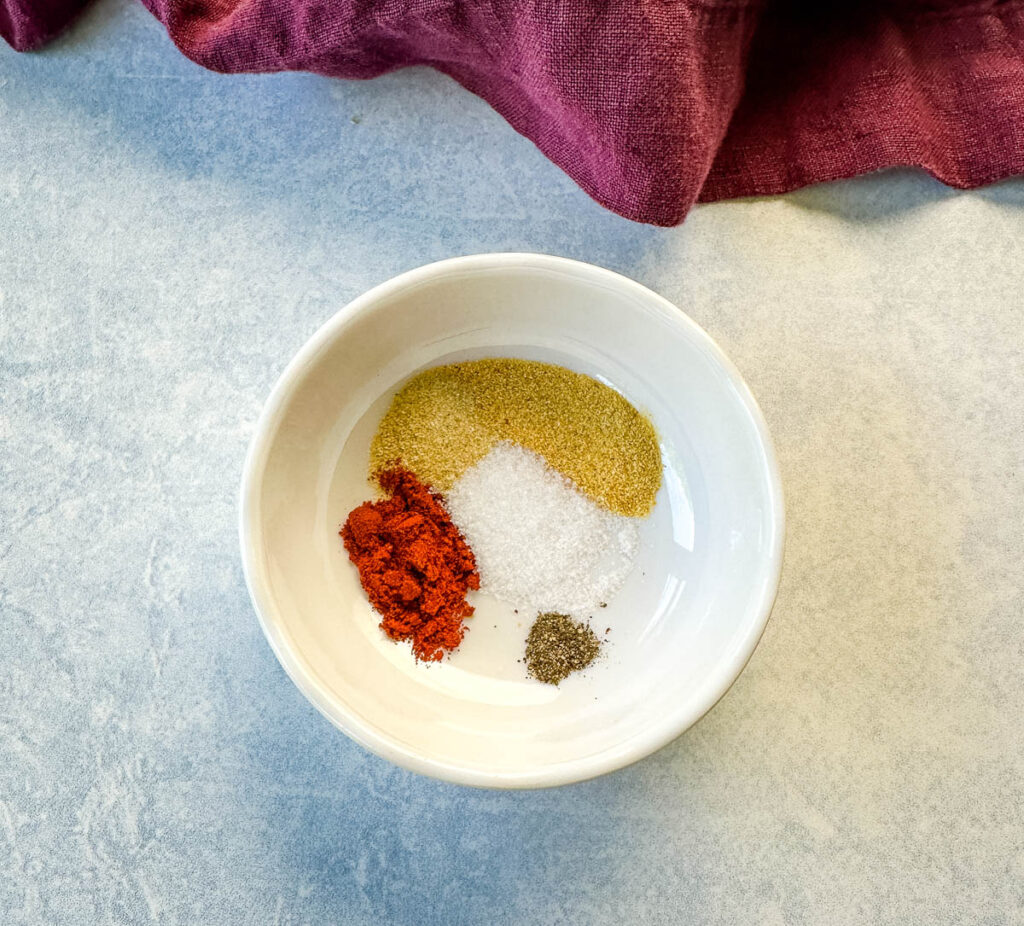
Ensure the Steak and Shrimp Are at Room Temperature
Allowing the steak and shrimp to come to room temperature before searing is a recommended step in the cooking process. This will help ensure more even and consistent cooking throughout the meat. Here’s why it’s beneficial:
- When the steak is at room temperature, it cooks more evenly. If the steak is too cold when it hits the hot pan, the outer surface may sear quickly while the inside remains cooler. Allowing the steak to warm up slightly ensures that the entire cut cooks more uniformly.
- A room-temperature steak will sear more efficiently, reducing the overall cooking time. This means you can achieve the desired level of doneness without overcooking the steak.
- A room-temperature steak will brown more evenly during searing, leading to a beautiful crust and enhancing the flavors.
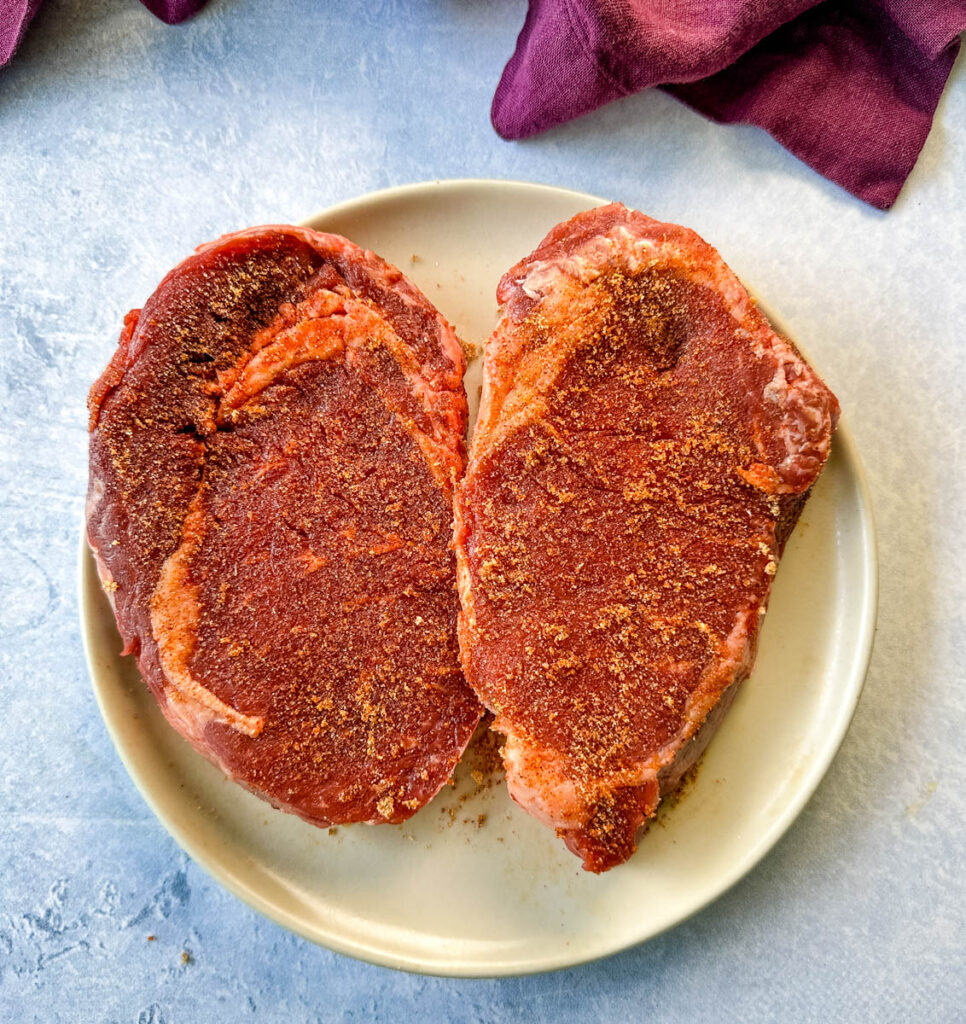
Do You Leave the Tails on the Shrimp
This is a matter of preference and is up to you. The tails add visual appeal to the presentation of the dish. Keeps it cute!
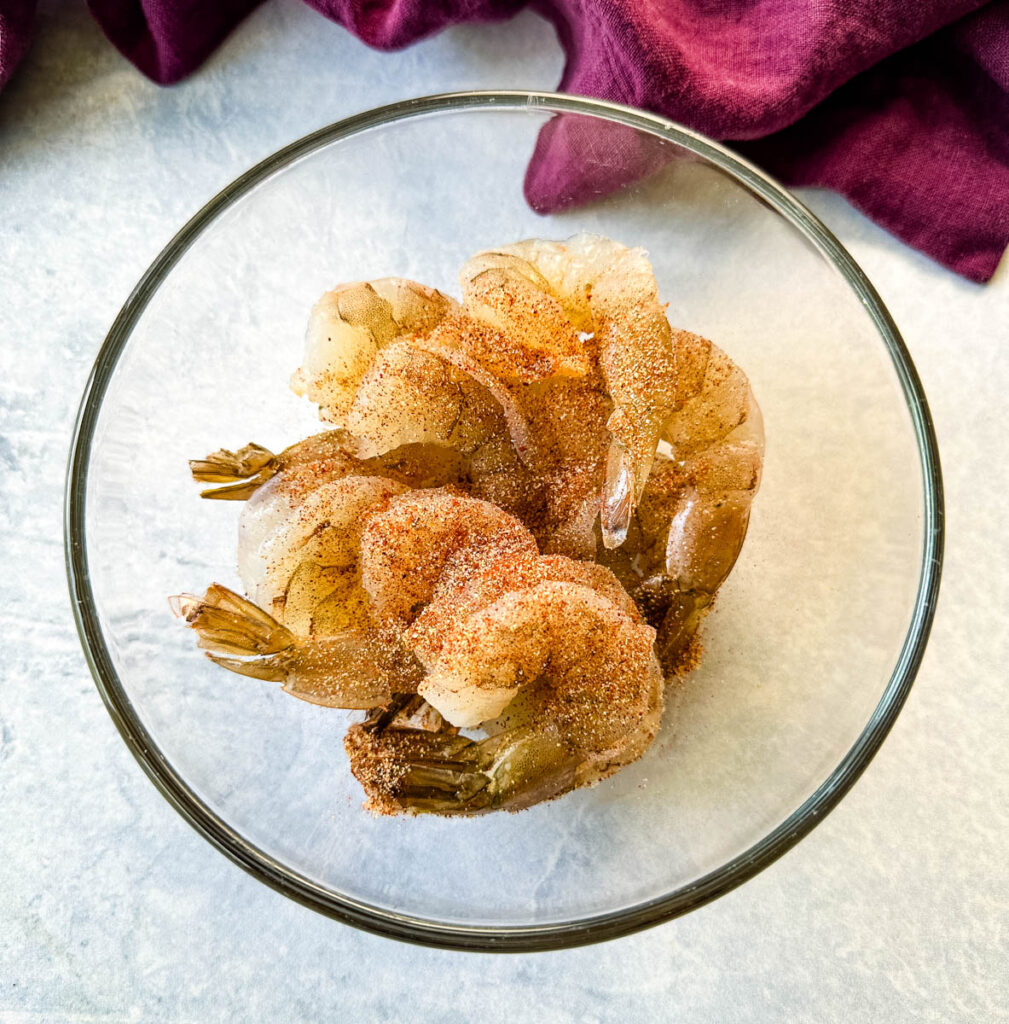
How to Make Steak and Shrimp
Full detailed instructions are below in the recipe card.
- Heat a cast iron or stainless steel skillet on medium-high heat with olive oil until hot.
- Sprinkle the spices onto both sides of the steaks and rub them into the meat.
- Coat the shrimp with the spices and ensure the shrimp are evenly coated.
- Add the steaks to the hot skillet. Sear both sides.
- Add the shrimp to the skillet and cook, flipping to cook each side.
- Cool before serving.
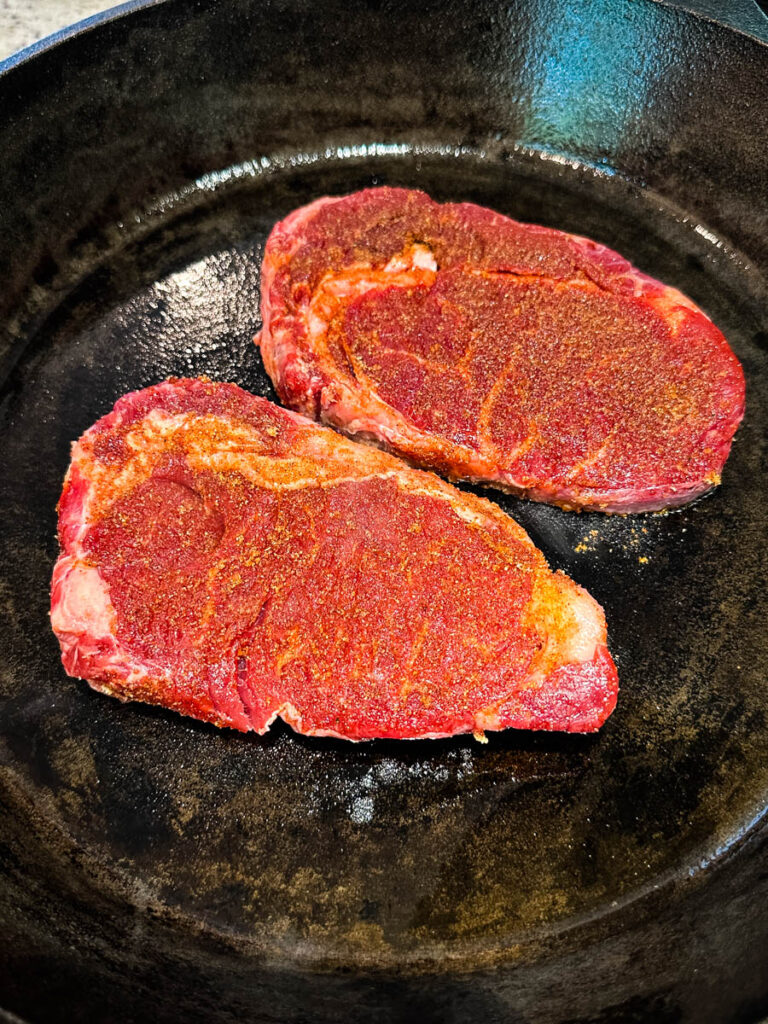
How to Know When the Steak is Done
- Internal temperature – Using a meat thermometer or probe to check the internal temperature is the best way to cook steak perfectly to your liking.
- Touch – Press the steak with your finger, a rare steak will feel soft and spongy, a medium-rare steak will have a little more resistance and a well-done steak will be super firm to the touch.
- Appearance – Take a look at the color of the steak. A rare steak will be bright red in the center, a medium steak will be mostly brown with a small amount of pink, and well done has little to no pink.
Internal Temperature Guide
- Rare: 120 degrees
- Medium-rare: 130 degrees
- Medium: 140 degrees
- Medium Well: 145 degrees
- Well-done: 160 degrees
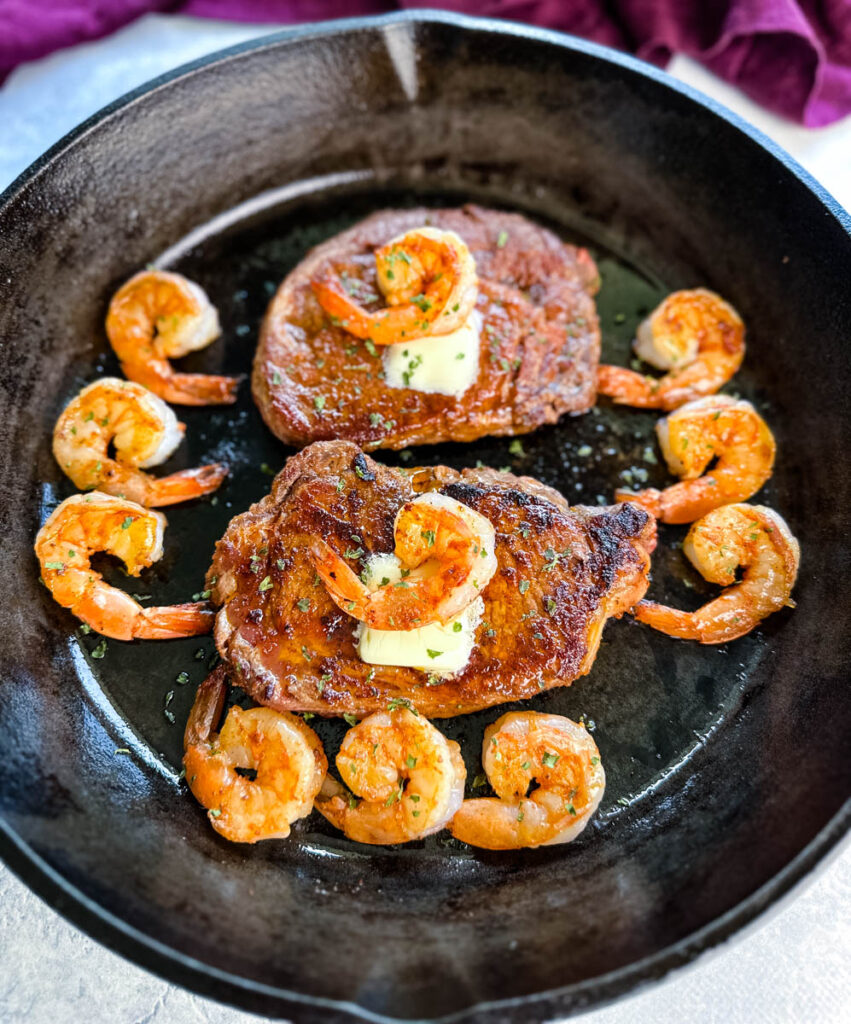
Allow the Steak to Rest
Be sure to allow the steak to rest for at least 10 minutes after cooking and before slicing it. During this time, the meat’s juices redistribute, which helps to improve the tenderness and overall flavor of the steak. Resting also allows the internal temperature of the steak to even out, preventing it from becoming overcooked when it’s sliced and served.
How to Tell When the Shrimp Are Done/Overcooked Shrimp
- Color change: Raw shrimp are translucent, but as they cook, they turn opaque and take on a pinkish color. When the shrimp have turned pink and opaque, they are cooked through.
- Firmness: Gently press the shrimp with your finger or a fork. Cooked shrimp should have a firm texture, yet still be tender. Overcooked shrimp may feel rubbery or excessively firm.
- Shape and Curling: Cooked shrimp tend to curl into a “C” shape. As they cook, the proteins contract, causing the shrimp to curl. When they are tightly curled in an O shape they are typically overcooked.
- Internal Temperature: Use a meat thermometer and insert it into the thickest part of the shrimp. The internal temperature should read between 120 degrees and 140 degrees.
How to Ensure the Steak and Shrimp are Ready at the Same Time
- Preparation: Before you start cooking, make sure all your ingredients and tools are ready. Have the steak and shrimp prepped, seasoned, and ready to go.
- Cooking Time Considerations: Keep in mind that shrimp cook much faster than steak. Depending on the size of the shrimp and the cooking method, shrimp generally take only a few minutes to cook, while steak can take longer.
- Cook Steak First: Since steak takes longer to cook, start by cooking the steak first. This will give the shrimp time to marinate and be prepped for cooking while the steak is on the grill or in the pan.
- Monitor Cooking Times: Keep a close eye on both the steak and shrimp as they cook, using cooking timers if necessary. Avoid distractions to ensure you don’t overcook either.
- Resting Time: Allow the steak to rest after cooking. While it rests, you can quickly finish cooking the shrimp. This resting period for the steak will also help ensure that it stays juicy and tender.
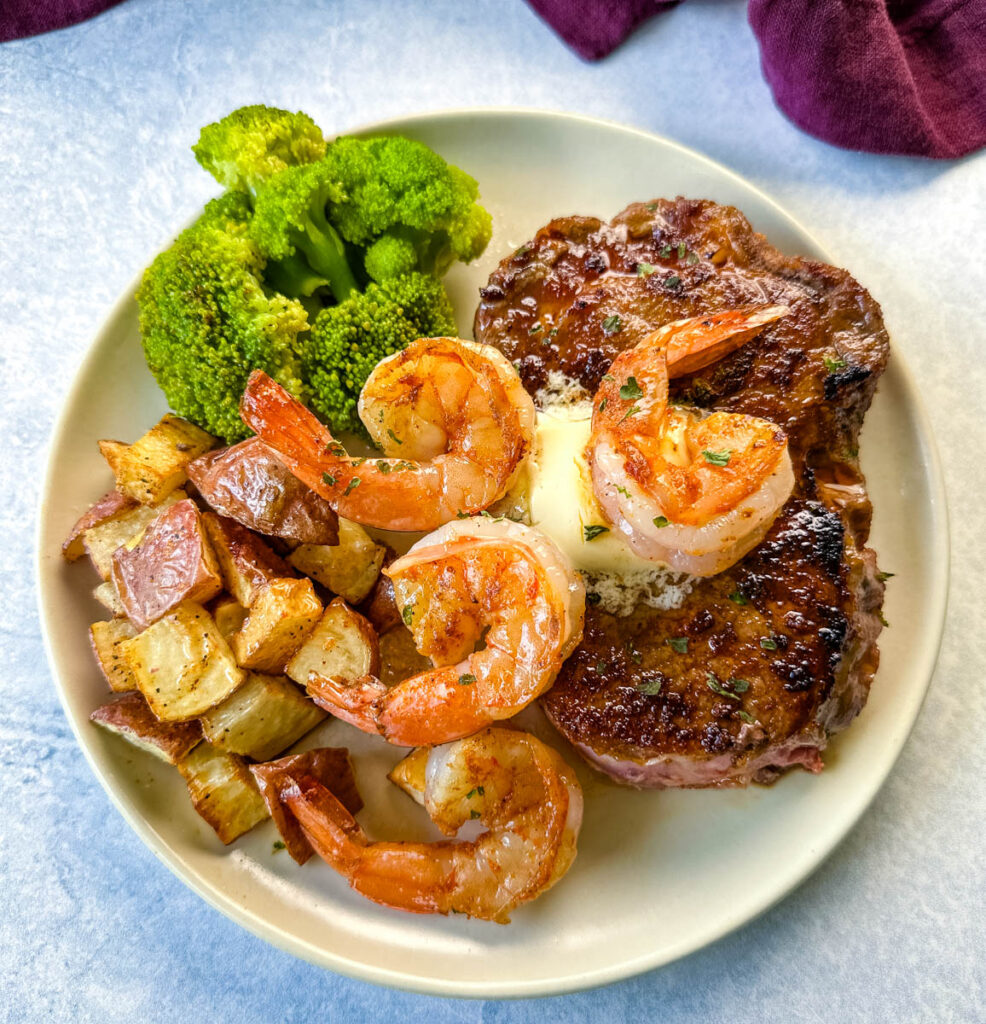
What Type of Pan to Use
- Cast Iron Skillet: An excellent choice for cooking both steak and shrimp. It retains heat well, provides even cooking, and can achieve high temperatures, perfect for searing steak and cooking shrimp quickly.
- Grill Pan: These are often made of cast iron. If you prefer grill marks on your steak and shrimp, a grill pan with raised ridges is an excellent alternative. It allows you to achieve grill-like sear marks indoors.
- Stainless Steel Skillet: These are durable and versatile. They can handle high heat and are ideal for achieving a nice sear on the steak and cooking shrimp to perfection.
- Carbon Steel Pan: Similar to cast iron, carbon steel pans have excellent heat retention and distribution properties. They are well-suited for searing steak and cooking shrimp at high temperatures.
- Non-Stick Skillet: A non-stick skillet can be a convenient option for cooking shrimp, as it requires minimal oil and helps prevent sticking. You likely won’t achieve an excellent sear or crust with this. For searing steak, a stainless steel or cast iron pan may be a better choice.
How to Store
Leftovers can be stored in the fridge tightly covered and sealed for 3-4 days.
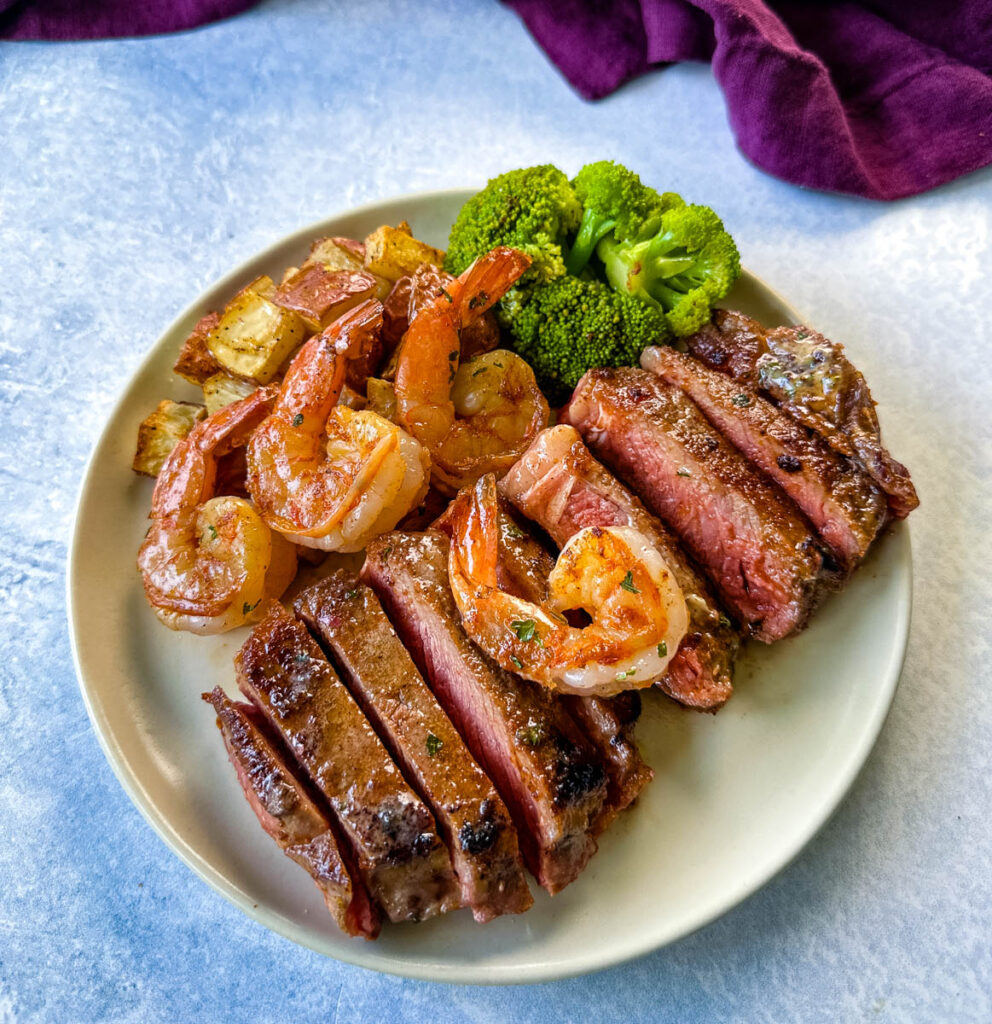
How to Reheat
Reheating Steak:
- Oven: Preheat your oven to 300 degrees. Wrap the steak in aluminum foil to retain moisture and prevent drying out. Place the wrapped steak on a baking sheet and reheat it in the oven until warm.
- Air Fryer: Add the steak and reheat at 350 degrees until warm.
- Pan Searing: Heat a skillet over medium heat. Add a small amount of oil or butter to the pan. Once the pan is hot, add the steak and reheat each side for 1-2 minutes or until it’s warmed through.
- Grill: Preheat your grill to medium-high heat. Brush the steak with a little oil to prevent sticking. Grill each side for 2-3 minutes or until warm.
Reheating Shrimp
Avoid overcooking the steak and shrimp during reheating, as they can become dry and lose their tenderness.
- Oven: Preheat your oven to 350 degrees. Arrange the shrimp in a single layer on a baking sheet. Reheat until they are warmed through.
- Air Fryer: Add the shrimp and reheat at 350 degrees until warm.
- Pan Searing: Heat a skillet or frying pan over medium heat. Add a small amount of oil or butter to the pan. Once the pan is hot, add the shrimp and reheat for 1-2 minutes on each side or until they are heated through.
- Grill: Preheat your grill to medium-high heat. Place the shrimp on a grill basket or skewers. Grill the shrimp for about 2-3 minutes on each side or until they are warm.
Freezer Tips
You can freeze the dish tightly covered and sealed for 2-3 months. Defrost in the fridge overnight.
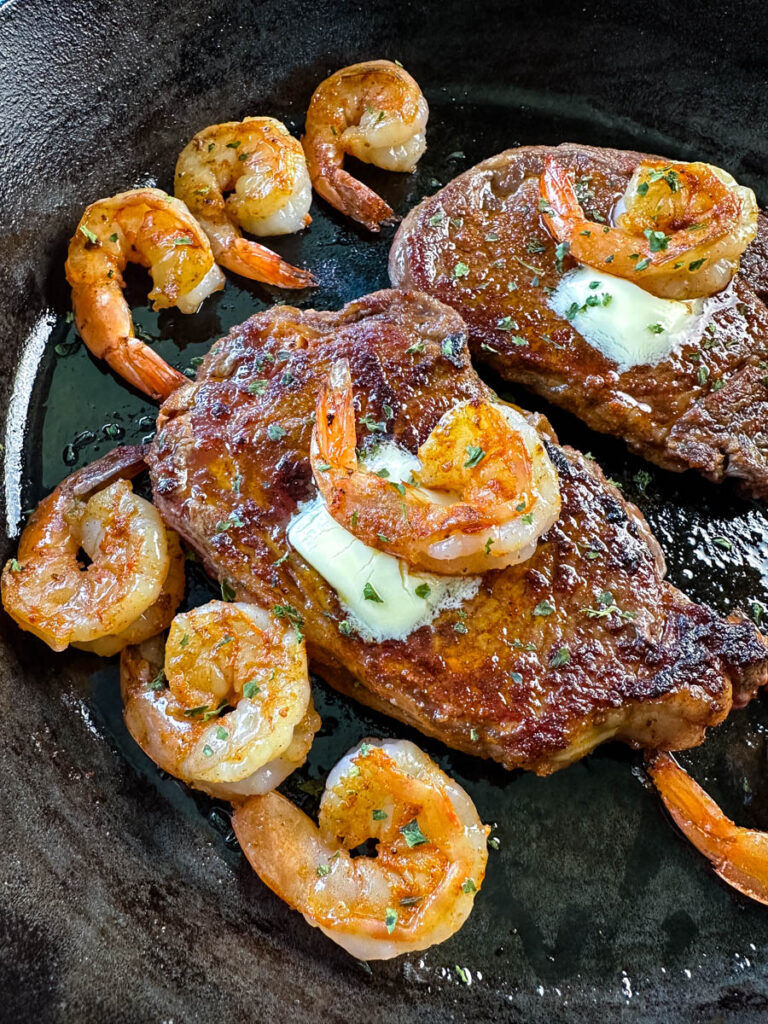
Delicious Sauces for Pairing
Homemade Seafood Shrimp Cocktail Sauce
Remoulade Sauce for Crab Cakes and Salmon
Crawfish Boil Sauce
Seafood Boil Sauce
Creamy Dill Sauce for Salmon
Mango Dressing (Fresh or Frozen)
Pair With These Recipes
Soul Food Southern Baked Mac and Cheese
Steakhouse Creamed Spinach
Smothered Potatoes and Onions
Green Bean Casserole with Bacon
More Shrimp Recipes
Creamy Shrimp and Corn Chowder with Potatoes
How to Make Shrimp Cocktail
Shrimp Enchiladas
Shrimp Taco Salad
Spicy Shrimp Tacos
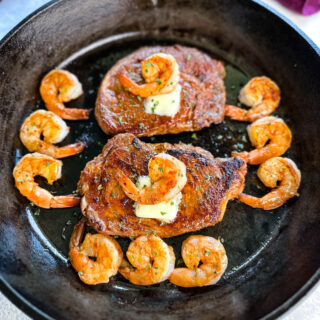
Steak and Shrimp Surf and Turf Recipe
Ingredients
- 2 steaks I used 2 9oz ribeyes.
- 1/2 pound raw shrimp peeled and deveined
- 1 teaspoon olive oil
Homemade Steak Rub (You can use your favorite store bought rub if preferred)
- 1 teaspoon brown sugar or sweetener
- 1 teaspoon smoked paprika
- 1/2 teaspoon onion powder
- 1/2 teaspoon garlic powder
- salt and pepper to taste
Homemade Shrimp Seasoning (You can use your favorite store bought rub if preferred)
- 1/2 teaspoon smoked paprika
- 1/4 teaspoon onion powder
- 1/4 teaspoon garlic powder
- salt and pepper to taste
Instructions
- Remove the steaks from the refrigerator and let them sit at room temperature for about 30 minutes to 1 hour before cooking.
- Heat a cast iron or stainless steel skillet on medium-high heat with the olive oil until hot.
- Pat the steaks dry to remove excess moisture.
- Sprinkle the spices onto both sides of the steaks and rub them into the meat. Ensure the steaks are evenly coated. Add additional spices if necessary.
- Coat the shrimp with the spices and ensure the shrimp are evenly coated. Add additional spices if necessary.
- Add the steaks to the hot skillet. Sear both sides of the steak for 3-4 minutes. Ensure the edges are seared. Cook time will vary depending on your desired doneness. Use a meat thermometer and cook to 125° F for rare, 135° F for medium-rare, 145° F for medium, 155° F for medium-well, and 160° F for well done.Remove the steak and allow it to rest while you cook the shrimp.
- Add the shrimp to the skillet and cook, flipping to cook each side, for 3-5 minutes or until it is pink and opaque.
- Cool before serving.
Notes
Air Fryer Steak
-
Pat the steak dry and season both sides with lemon pepper seasoning, garlic powder, smoked paprika, salt, and pepper to taste.
-
Cook for 5 minutes on 370 degrees. After 5 minutes, open the air fryer and test the internal temperature. Cook for an additional 2-7 minutes.Cook time will vary depending on your desired doneness. Use a meat thermometer and cook to 125° F for rare, 135° F for medium-rare, 145° F for medium, 155° F for medium-well, and 160° F for well done.
-
Drizzle the steak in the lemon butter sauce. Allow the steak to rest for at least 3 minutes before slicing or consuming.
Air Fryer Shrimp
-
Air fry the shrimp at 400 degrees for 6-8 minutes or until it is pink and opaque.
- Feel free to trim the fat from your steaks or shape them up to your liking.
- Allow the steak to come to room temperature (about 30 minutes) prior to cooking. This will allow the steak to cook at an even and consistent temperature. If you add it to a hot pan while cold, the muscle fibers will tense up and result in tough steak.
- Allow the meat to rest for at least 5-10 minutes before slicing or consuming. If you slice into the steak too soon, that will cause the inside moisture within the steak to spill out onto the plate, leaving a drier, less flavorful steak.
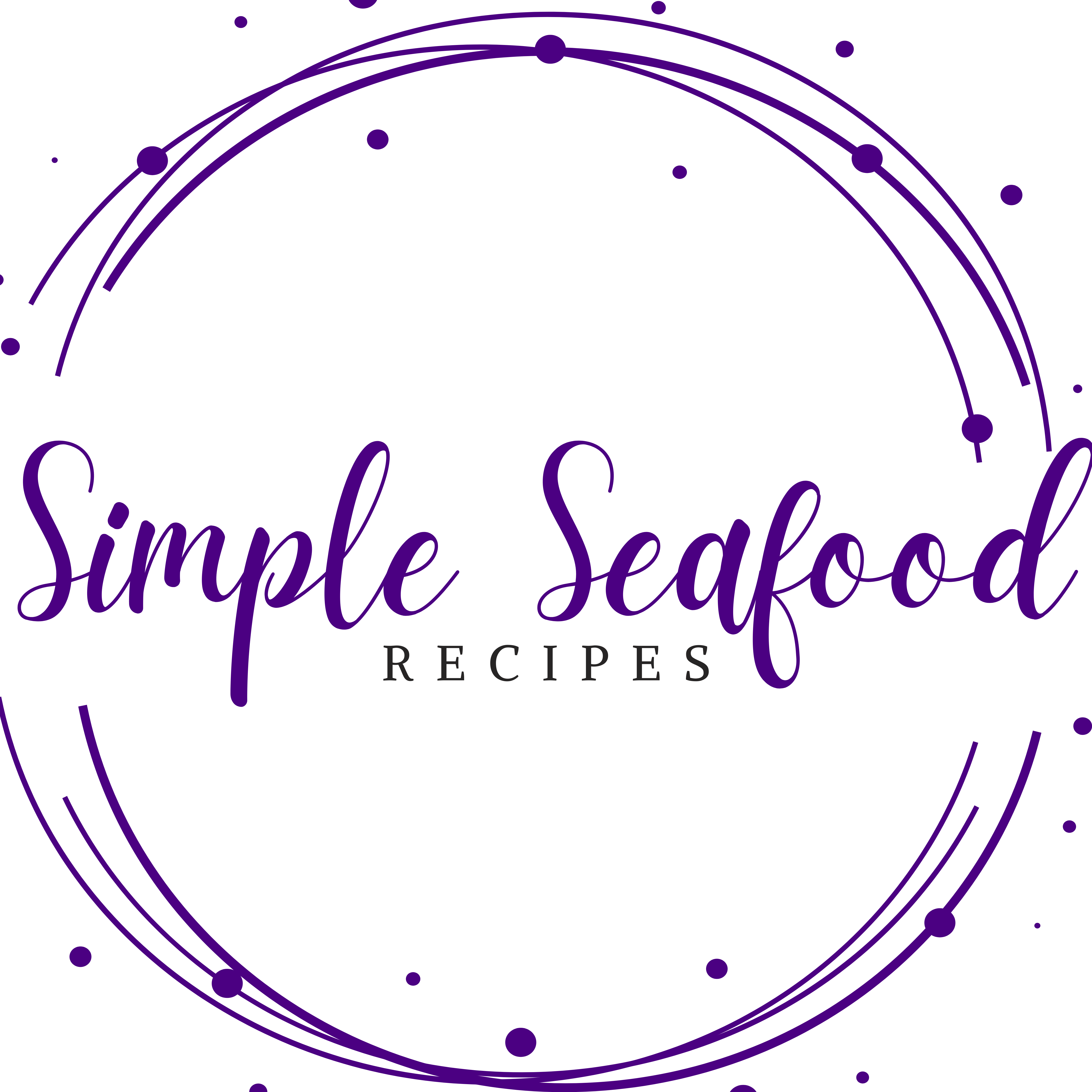
Heather
Wednesday 26th of July 2023
Perfect timing--using this recipe on our Blackstone this week!
Brandi Crawford
Monday 31st of July 2023
I hope you love it!